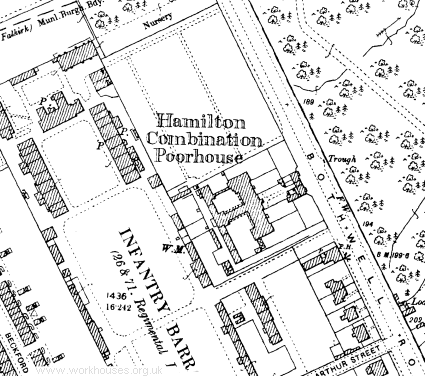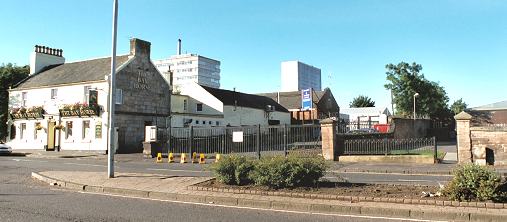Hamilton Combination, Lanarkshire
Hamilton Combination was formed in 1866 and comprised the 8 parishes of Avondale, Blantyre, Cambuslang, Dalserf, Glassford, Hamilton, East Kilbride and Stonehouse. The total population of the member parishes in 1881 was 68,882.
Erection of a Hamilton Combination Poorhouse began soon afterwards at a site on the west side of Bothwell Road in Hamilton, near the army barracks. It received its first admissions in 1867 and could accommodate around 220 inmates. The site location and layout are shown on the 1896 map below.

Hamilton poorhouse site, 1896
The was typical of smaller Scottish poorhouses. A small entrance block and porter's lodge lay at the north-east of the site. The T-shaped main block faced to the north-east. At its centre would probably have been the Governor's quarters with the dining-hall and kitchen behind. Separate male and female accommodation was provided at each side. At the rear of the main building were various utility rooms and workshops.
Conditions in Hamilton poorhouse left much to be desired. In 1904, the Local Government Board declared the probationary wards to be inadequate and insufficient even for healthy persons. Complaints included the provision of only one bath, used by both men and women. In 1910, Dr Dewar, an LGB inspector, visited the site and made many recommendations for improvements. After these went ignored, a second visit was made in 1913. The faults still found included:
- The buildings were dilapidated, poorly furnished, and in need of redecoration. There were half-inch cracks in some of the walls.
- There were numerous rats in the building.
- The ventilation, heating and gas lighting were poor.
- The fixed rows of narrow pew-like benching in the dining room made cleaning difficult. The limited accommodation necessitated two sittings at meal-times.
- The pigsty had bad drainage leading to smells and flies entering the poorhouse.
- The reception room for inmates' visitors was tiny.
- The Nursery was too small, had no lavatory or running water, and was infested with rats.
- Wards for the sick were in the main building and were inadequate.
However, all was not entirely bad. On the positive side, Dewar found that inmates food was good and the work done by the inmates — producing sticks and firelighters — sold well. The inmates were given concerts once a month, occasional cinema shows, and a sufficient supply of books and newspapers. As a result of the second inspection, Hamilton agreed to renovate the poorhouse and build a separate hospital.
In 1928, a number of male inmates instituted a lightning strike and refused to work. The incident, sparked by lumpy porridge, followed a number of earlier complaints about the rations being provided at the poorhouse. The police were summoned by the governor but said they were unable to interfere so long as the strikers refrained from creating a breach of the peace.
After 1930, the poorhouse became the Hamilton Home Poor Law Institution. The poorhouse buildings no longer exist.

Hamilton former poorhouse site from the east, 2001.
© Peter Higginbotham.
Staff
Inmates
Records
Note: many repositories impose a closure period of up to 100 years for records identifying individuals. Before travelling a long distance, always check that the records you want to consult will be available.
- Glasgow City Archives, The Mitchell Library, 210 North Street, Glasgow G3 7DN, Scotland. Holdings include Poorhouse book (1912-60).
Bibliography
- Government and Social Conditions in Scotland 1845-1919 by Ian Levitt (1988, Scottish History Society)
Links
- None.
Unless otherwise indicated, this page () is copyright Peter Higginbotham. Contents may not be reproduced without permission.


